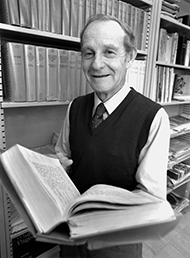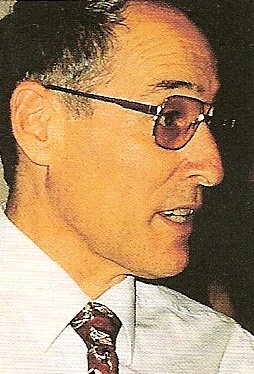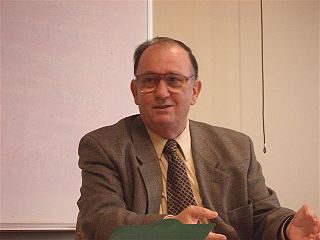The Book of Habakkuk is the eighth book of the 12 minor prophets of the Bible. It is attributed to the prophet Habakkuk, and was probably composed in the late 7th century BC. The original text was written in the Hebrew language.

The Septuagint, sometimes referred to as the Greek Old Testament or The Translation of the Seventy, and often abbreviated as LXX, is the earliest extant Greek translation of the Hebrew Bible from the original Hebrew. The full Greek title derives from the story recorded in the Letter of Aristeas to Philocrates that "the laws of the Jews" were translated into the Greek language at the request of Ptolemy II Philadelphus by seventy-two Hebrew translators—six from each of the Twelve Tribes of Israel.

David Noel Freedman was an American biblical scholar, author, editor, archaeologist, and, after his conversion from Judaism, a Presbyterian minister. He was one of the first Americans to work on the Dead Sea Scrolls. He is the son of the writer David Freedman. He died of a heart ailment.

Emanuel Tov is a Dutch–Israeli biblical scholar and linguist, emeritus J. L. Magnes Professor of Bible Studies in the Department of Bible at the Hebrew University of Jerusalem. He has been intimately involved with the Dead Sea Scrolls for many decades, and from 1991, he was appointed Editor-in-Chief of the Dead Sea Scrolls Publication Project.
James A. Sanders was an American scholar of the Old Testament/Hebrew Bible and one of the Dead Sea Scrolls editors. Sanders grew up in racially segregated Memphis, attended a Methodist church, and went to Nashville to attend Vanderbilt University where he associated with Baptist & Methodist fellowships. He was the first to translate and edit the Psalm Scroll, which contained a previously unknown psalm. Sanders retired in the late 1990s, but published and lectured regularly into his 90s.

John Strugnell was an English Professor Emeritus at the Harvard Divinity School and a former editor-in-chief of the Dead Sea Scrolls project. Strugnell became, at 23, the youngest member of the team of scholars led by Roland de Vaux, formed in 1954 to edit the Dead Sea Scrolls in Jerusalem. He was studying Oriental languages at Jesus College, Oxford when Sir Godfrey Rolles Driver, a lecturer in Semitic philology, nominated him to join the Scrolls editorial team.

Frank Moore Cross Jr. was the Hancock Professor of Hebrew and Other Oriental Languages at Harvard University, notable for his work in the interpretation of the Dead Sea Scrolls, his 1973 magnum opusCanaanite Myth and Hebrew Epic, and his work in Northwest Semitic epigraphy. Many of his essays on the latter topic have since been collected in Leaves from an Epigrapher's Notebook.

Elisha Qimron is an academic who studies ancient Hebrew. He took his Doctor of Philosophy in 1976 at the Hebrew University of Jerusalem with the dissertation The Hebrew of the Dead Sea Scrolls.
Eugene "Gene" CharlesUlrich is an American Dead Sea scrolls scholar and the John A. O'Brien Professor emeritus of Hebrew Scripture and Theology in the Department of Theology at the University of Notre Dame. He is chief editor of the biblical texts of the Dead Sea scrolls and one of the three general editors of the Scrolls International Publication Project. Ulrich has worked under two editors in chief on the scrolls project, namely John Strugnell and Emanuel Tov.
Mark Stratton John Matthew Smith is an American Old Testament scholar and professor.
Noel Beldon Reynolds is an American political scientist and an emeritus professor of political science at Brigham Young University (BYU), where he has also served as an associate academic vice president and as director for the Foundation for Ancient Research and Mormon Studies (FARMS). He was a member of the BYU faculty from 1971 to 2011. He has also written widely on the theology of the Church of Jesus Christ of Latter-day Saints, of which he is a member.

The Genesis Apocryphon (1Q20), also called the Tales of the Patriarchs or the Apocalypse of Lamech and labeled 1QapGen, is one of the original seven Dead Sea Scrolls discovered in 1946 by Bedouin shepherds in Cave 1 near Qumran, a small settlement in the northwest corner of the Dead Sea. Composed in Aramaic, it consists of four sheets of leather. Furthermore, it is the least well-preserved document of the original seven. The document records a pseudepigraphal conversation between the biblical figure Lamech, son of Methuselah, and his son, Noah, as well as first and third person narratives associated with Abraham. It is one of the nonbiblical texts found at Qumran. A range of compositional dates for the work have been suggested from the 3rd century BC to 1st century AD. Palaeography and Carbon-14 dating were used to identify the age of the documents. It is 13 inches in length and 2.75 inches in width at its widest point in the middle.
Loren T. Stuckenbruck is a historian of early Christianity and Second Temple Judaism, currently professor of New Testament at the University of Munich, in Germany. His work has exerted a significant impact on the field.
John J. Collins is an Irish-born American biblical scholar, the Holmes Professor of Old Testament Criticism and Interpretation at Yale Divinity School. He is noted for his research in the Hebrew Bible, as well as the apocryphal works of the Second Temple period including the sectarian works found in Dead Sea Scrolls and their relation to Christian origins. Collins has published and edited over 300 scholarly works, and a number of popular level articles and books. Among his best known works are the Between Athens and Jerusalem: Jewish Identity in the Hellenistic Diaspora ; Daniel in the Hermeneia commentary series ; The Scepter and the Star. The Messiahs of the Dead Sea Scrolls and Other Ancient Literature ; and The Bible after Babel: Historical Criticism in a Postmodern Age.
Bernard Malcolm Levinson serves as Professor of Classical and Near Eastern Studies and of Law at the University of Minnesota, where he holds the Berman Family Chair in Jewish Studies and Hebrew Bible. He is the author of Deuteronomy and the Hermeneutics of Legal Innovation, "The Right Chorale": Studies in Biblical Law and Interpretation, and Legal Revision and Religious Renewal in Ancient Israel; and is the co-editor of The Pentateuch as Torah: New Models for Understanding Its Promulgation and Acceptance. He has published extensively on biblical and ancient Near Eastern law and on the reception of biblical literature in the Second Temple period. His research interests extend to early modern intellectual history, constitutional theory, the history of interpretation, and literary approaches to biblical studies.

Michael Edward Stone is a professor emeritus of Armenian Studies and of Comparative Religion at the Hebrew University of Jerusalem. His research deals with Armenian studies and with Jewish literature and thought of the Second Temple period. He is also a published poet.
Millar Burrows was an American biblical scholar, a leading authority on the Dead Sea scrolls and professor emeritus at Yale Divinity School. Burrows was director of American School of Oriental Research in Jerusalem, and later president of the American Schools of Oriental Research. His grandson, Edwin G. Burrows (1943–2018), was an American historian and winner of the Pulitzer Prize (1999). His great-granddaughter, Kate Burrows, is a professor of public health at the University of Chicago.
Peter W. Flint was involved in research of the Dead Sea Scrolls for over 20 years. He was one of the 70 official members of the Dead Sea Scrolls editors worldwide. As the controversy of publishing of the Dead Sea Scrolls escalated, in 1987 he moved from South Africa to the University of Notre Dame in Indiana where he took a doctoral fellowship and began to study under Eugene Ulrich, the chief editor of the biblical Dead Sea Scrolls and one of the central figures of the controversy. In 1997, Flint finished publishing the Psalms Scrolls: the second largest portion of the biblical Dead Sea Scrolls. This publication is full of discoveries providing insights for Bible translations, Bible study and biblical scholarship. Flint was an editor of the largest intact scroll: The Great Isaiah Scroll. He served at Trinity Western University as a professor of Religious Studies, the Canada Research Chair in Dead Sea Scrolls Studies, and a director of the Dead Sea Scrolls Institute. He died on November 3, 2016.
Eileen Marie Schuller is a professor at the Faculty of Social Sciences at McMaster University in Hamilton, Ontario. Schuller is an official editor of the Dead Sea Scrolls. She teaches undergraduate and graduate studies in the Biblical field. Over a span of 30 years, her involvement in the publication of the Dead Sea Scrolls has led to numerous contributions in authenticating the discoveries found in the caves near the Ancient Qumran settlement.
Kristin Mimi Lieve Leen De Troyer is an Old Testament scholar, theologian, writer and an (honorary) professor who has taught at different universities such as the University of Salzburg, the University of St Andrews, and Claremont School of Theology. She is the author of many scholarly books and articles, an editor of several academic series, and a professor and researcher of the Hebrew Bible, the Septuagint, Judaism and the Dead Sea Scrolls. Since the beginning of 2021, she serves as the Secretary of the European Academy of Sciences and Arts.








